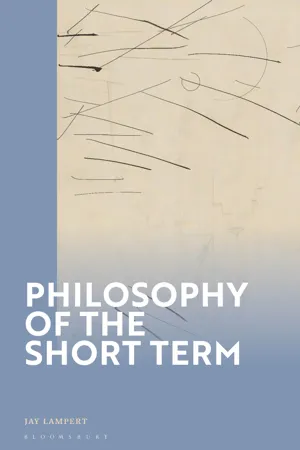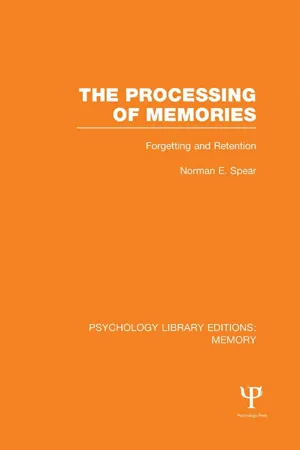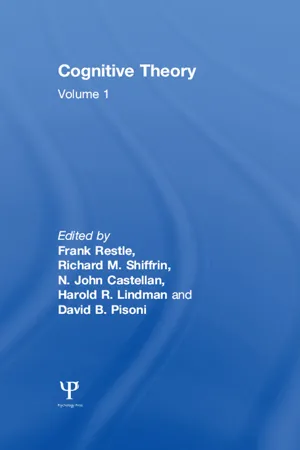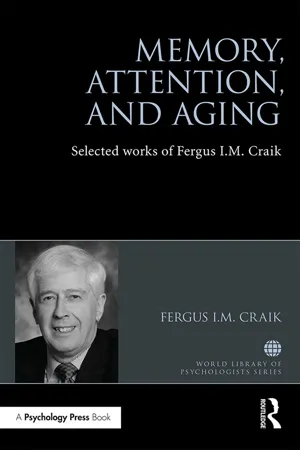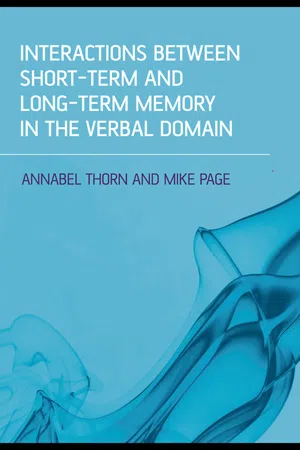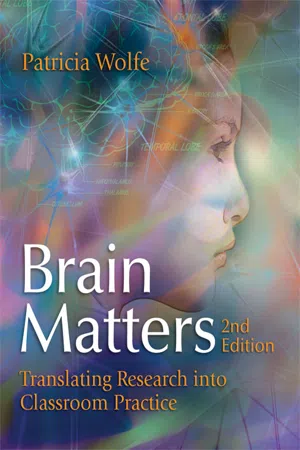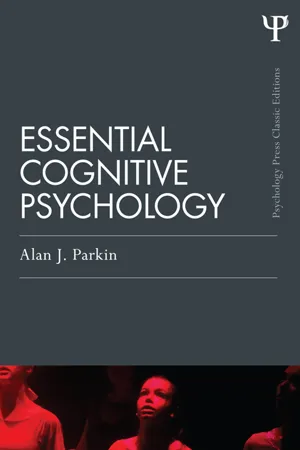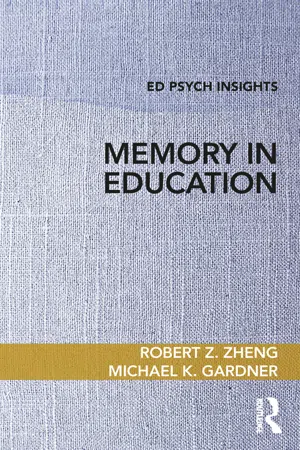Psychology
Short-term Retention
Short-term retention refers to the temporary storage of information in the memory system for a brief period, typically lasting from a few seconds to a minute. It involves the ability to hold and manipulate a small amount of information in the mind, such as remembering a phone number long enough to dial it. This process is essential for various cognitive tasks and problem-solving.
Written by Perlego with AI-assistance
Related key terms
9 Key excerpts on "Short-term Retention"
- eBook - ePub
- Jay Lampert(Author)
- 2023(Publication Date)
- Bloomsbury Academic(Publisher)
There must be short term retentions that make experience feel continuous from one moment to the next, as well as some long term storage of a knowledge base. When we listen to a person talking, for example, we have to retain the beginning of a heard word while we hear the end of it, and we have to know the meaning of the words, which we will have learned a long time ago. This kind of example leads Roman Jakobson to say that, “the role of short- and long-term memory constitutes one of the central problems of both general linguistics and the psychology of language.” 2 The literature in cognitive psychology on short term memory is complicated and disputed. I will draw from two frequently cited survey articles: Nelson Cowan’s “What are the differences between long-term, short-term, and working memory?” in Progress in Brain Research, 2008 ; 3 and Bart Aben et al., “About the Distinction between Working Memory and Short-Term Memory” in Frontiers in Psychology, 2012. 4 The conceptual speculations below about the meaning of the short term are my own. Short term memory is memory for a particular experienced image retained (again, in what Husserl calls secondary retention) only for a short amount of time, or to be more operationally precise, memory that can only be recalled a short amount of time later. One might think that short term memory is memory that simply lasts a shorter amount of time than long term memory. But we will see that most theorists of memory think of “memory” as an equivocal term, naming two different functions (not including “primary retention”) that may be performed on an original experience, one of which leads to its short term retention, and one of which leads to its long term retention. Short and long term memory thus tend to be defined primarily by the operations they perform on the original experience, and only secondarily by the length of time the original experience lasts - eBook - ePub
The Processing of Memories (PLE: Memory)
Forgetting and Retention
- Norman E. Spear(Author)
- 2014(Publication Date)
- Psychology Press(Publisher)
3Retention after Short Intervals
OVERVIEW OF SIMPLE RETENTION
Analytical research on memory processing often involves the systematic application of treatments that commonly result in forgetting. One such treatment is to teach the organism competing memories that interfere with retention of the target memory; another is to induce physiological malfunction, especially in the central nervous system. Of central interest in this chapter and the next is “simple retention,” the retention that occurs in organisms that have not been treated in such a way as to explicitly induce forgetting. We thus minimize consideration of forgetting that results from unusual sources of interference or physiological malfunction, whether purposely administered or accidentally encountered by the organism. Later we shall consider how such events result in retention loss and why this occurs. For now, we are concerned primarily with simple retention, the object of interest when we ask what portion of the words a person has learned will be given correctly by him a few seconds, minutes or hours later. Similarly, simple retention is the issue when we measure the probability that a rat will turn right in a maze one minute or one month after it has learned that food may be obtained on the right side but not on the left, or when we briefly present a symbol to a monkey and test whether it can distinguish it from among others after a 4-minute retention interval.The most important environmental circumstances for simple retention is length of the retention interval. As mentioned earlier, “retention interval” is defined as any interval longer than that necessary to establish original learning; with multit-rial learning, the retention interval must be longer than the intertriai interval. In the study of simple retention, no attempt is made to modify the events that ordinarily would occur during that interval in the organism’s life cycle, except that measures are taken to prevent additional practice on the episode to be remembered: Humans should be treated in a manner that would prevent rehearsal during the retention interval, and animals should be housed away from the circumstances of learning. - eBook - ePub
Cognitive Theory
Volume 1: Cognitive Theory
- F. Restle, R. M. Shiffrin, N. J. Castellan, Jr., H. R. Lindman, D. B. Pisoni(Authors)
- 2018(Publication Date)
- Psychology Press(Publisher)
Fig. 1 long-term store is divided by a dotted line into long-term working memory and a permanent repository. This division is indicated to reflect the difference between information stored in such a way that retrieval will depend upon temporarily available context, and information stored in such ways that retrieval will occur even when appropriate local context cues are not available. Of course, we imply no hard and fast division here—some “temporary” context cues could well last for years. We wish to emphasize, moreover, that much long-term forgetting, even of “semantically” stored information, may occur as a result of contextual changes in the retrieval probe.One consequence of this “contextual” view is that it can handle and predict the data presented in the Craik and Jacoby chapter. For example, coding by phonemic or semantic methods might make little difference if retrieval was primarily dependent upon temporal–contextual cues. On the other hand, a delayed test might force the subjects to switch to a semantic retrieval mode and a recall difference will appear. Indeed, this explanation is similar to that presented by Craik and Jacoby. My working memory and their episodic memory are quite similar, save that I do not impose any conditions of strict temporal ordering, and I prefer to incorporate the working memory within LTS. Finally, note that the contextual model can predict the results of Bjork and Whitten (1974) in which an immediate long-term test shows primacy and recency effects that a more delayed test does not show.SUMMARYIn this presentation I have developed the concept of STS as the control center for active cognitive functioning. Sensory icons are placed within STS as active available sets of information. Short-term store is considered to be the beneficiary of the results of a series of processing stages, each activating features or information which then serve as the bases for further processing. Attention is shown to be a result of the rehearsal, coding, retrieval, and forgetting properties of STS, rather than a property of the perceptual stages of encoding. A variety of retrieval mechanisms are ascribed to STS and selective attention is described as a concomitant of these: Failures of attention are equated with failures to retrieve information before forgetting occurs. Short-term capacity and forgetting are modeled as the result of a stochastic process: A great deal of information can be maintained for short periods of time, or a much smaller set of information for longer periods of time. Loss from STS is ascribed to interference by similar information as a root cause, but the loss itself was shown to occur stochastically, over time. Storage in LTS, or transfer from STS to LTS, is shown to be relatively independent of the time of residence of a trace within STS. It is argued that rehearsal and coding operations are the active agents in the transfer process: Heavy weight is given to the level of the information being rehearsed or coded. Finally, the role of STS in long-term memory and forgetting is discussed. Contextual information in STS is given great importance as a retrieval cue, and it is shown how context could provide a basis for “episodic” memory. Data are presented indicating how longterm forgetting might be associated with changes in the availability of contextual cues. - eBook - ePub
Memory, Attention, and Aging
Selected Works of Fergus I. M. Craik
- Fergus Craik(Author)
- 2016(Publication Date)
- Routledge(Publisher)
Part 1 Short-Term or Primary MemoryThe idea that episodic memory can be divided into two main compartments or processes has appeared in various forms in human experimental psychology over the last 150 years. The basic distinction is between memory for material presented and recalled recently, and material acquired some time ago, with the two stores or systems referred to typically as short-term memory (STM) and long-term memory (LTM). William James (1890) was one of the first writers to describe the two systems explicitly; he distinguished "primary memory" from "memory proper," where primary memory referred to information just experienced and still maintained in conscious awareness, as opposed to stored information that must be retrieved in order to be re-experienced. The notion of two different systems emerged again strongly with the advent of information-processing models of attention and perception. For example, Broadbent's (1958) model had a pre-attentive "s-system" and a limited capacity "p-system." Incoming material could be held briefly in the s-system before selection by the attentional filter mechanism, then identified and experienced consciously in the p-system, and if necessary recycled through the s-system. This last procedure enabled the participant to rehearse the material until a response was required.Research on STM was further boosted by articles written by John Brown (1958) in England and by Lloyd and Margaret Jean Peterson (1959) in the US. Both studies showed that retention of small amounts of material fell off drastically after only a few seconds of interfering activity. For example the Petersons found that memory for three-letter stimuli fell to 10 percent after 18 seconds of counting backwards. Murdock (1961) followed these demonstrations by showing that three words were forgotten at the same rate as three letters, and therefore concluded that the appropriate unit of storage in STM is "the chunk"—any meaningfully integrated unit of information. The growing enthusiasm for a separate short-term store was dampened, however, by Melton (1963) who argued that the hallmarks of memory in general were (a) learning to increase retention and (b) interference - eBook - ePub
- Alan J. Parkin(Author)
- 2014(Publication Date)
- Psychology Press(Publisher)
Sequences of these different types of string were presented and it was found that the number of errors in sequence repetition decreased systematically as strings closer in their approximation to English were used. This finding reflects the chunking that subjects were able to do, e.g. remembering “ERE” as opposed to “E”, “R”, “E”.The above findings demonstrate that the capacity of short-term store will vary depending on the nature of the information being remembered. This finding illustrates a fundamental problem in attempting to measure human memory capacity. Artificial storage systems such as floppy discs, compact discs, and magnetic tapes, have measurable fixed capacities because information is fed into them in the form of basic information units (e.g. “bytes” of information). In order to measure the capacity of human memory we would first need some similar method for reducing any to-be-remembered information into basic units. This may be possible in the future but, at present, our lack of a basic unit for measuring the size of different pieces of information put into memory precludes any attempt to measure memory capacity accurately.Long-term recencyConsider the following experiment. Subjects are presented with nine pairs of words to learn. Each pair is presented for 2 seconds followed by a period of distracting activity (mental arithmetic). After the last pair there is a further period of distraction before recall of the nine pairs is attempted. In version ‘A’ the period of distraction between each pair is 4 seconds followed by a final distraction period of 12 seconds. In version ‘B’ the period of distraction between each pair is 12 seconds and the final distraction period is 36 seconds. - Annabel Thorn, Mike Page(Authors)
- 2008(Publication Date)
- Psychology Press(Publisher)
1 Current issues in understanding interactions between short-term and long-term memoryAnnabel S.C.Thorn and Mike P.A.Page
Introduction
Investigation of the association between memory systems dedicated to the retention of information over the short or long term has occupied the minds of psychologists for many years. The idea that human memory is not a single system that operates across all time frames, but rather comprises dissociable short- and long-term memory components, goes back to William James (1890). James distinguished between primary memory, which he viewed as our awareness of what has just happened, and secondary memory, proposed to be our knowledge of events that have left our consciousness and are therefore part of the “psychological past”. More than fifty years later the notion of dissociable short- and long-term memory systems was supported by Hebb (1949), who suggested that the distinction between primary and secondary memory has a neurophysiological basis; the former, he proposed, reflects temporarily reverberating electrical activity in the brain, whereas the latter results from permanent synaptic changes.The distinction between short- and long-term memory systems was captured in the highly influential “modal model” of memory proposed by Atkinson and Shiffrin (1968). According to this model, incoming information is first processed by parallel sensory buffers and then enters a limited capacity short-term store. To enter long-term memory, Atkinson and Shiffrin proposed that information must be “copied” from the short-term store, with transfer occurring via rehearsal processes. The proposal that information can only gain access to long-term memory via short-term storage has been one of the most widely debated features of this model. For example, a number of reports document neuropsychological patients with grossly impaired short-term memory span who show generally unimpaired long-term learning (Basso et al., 1982; Shallice & Warrington, 1970), a cognitive profile that is not consistent with the assumption that all information must pass through short-term memory in order to be stored in long-term memory. Having said that, such patients do show a specific deficit in their ability to learn long-term representations of sequences (e.g., novel word-forms), suggesting that a modified view may be viable, in which the representation of a sequence- eBook - ePub
Brain Matters
Translating Research into Classroom Practice
- Patricia Wolfe(Author)
- 2010(Publication Date)
- ASCD(Publisher)
structural—properties of the human memory system. None of the three broad divisions of human memory is a separate, dedicated storage area in a particular region of the brain. This model summarizes the broad range of memory phenomena from the perspective of information processing. Most scientists agree that memory is a multifaceted, complex process that involves activating a large number of neural circuits in many areas of the brain. There is no uniform agreement, however, on a model that accurately represents these many facets. Some researchers view short-term memory and working memory as different processes; others consider working memory to be part of short-term memory. Some cognitive scientists do not believe that working memory and long-term memory are totally separate but that working memory is best conceptualized as a portion of long-term memory that is temporarily activated (Wagner, 1996). This is similar to Hebb's view that memory represents continued activity or reverberation of the neural cells involved in perception. Today, most scientists seem to prefer the term "working memory" to "short-term memory," as the former better characterizes the many complex activities that it represents. (Both sensory and working memory are of short duration, so in a sense they could both be considered "short-term.")Most scientists agree that memory is a multifaceted, complex process that involves activating a large number of neural circuits in many areas of the brain.Working memory allows us to integrate current perceptual information with stored knowledge and to consciously manipulate the information (think about it, talk about it, and rehearse it) well enough to ensure its storage in long-term memory.Working memory allows us to integrate current perceptual information with stored knowledge and to consciously manipulate the information (think about it, talk about it, and rehearse it) well enough to ensure its storage in long-term memory. We should not think of working memory solely as a conduit to long-term memory, however; much incoming sensory information is needed only temporarily and then discarded. Working memory appears to serve other purposes as well. Cognitive psychologist B. F. Pennington refers to working memory as a "computational arena," in which information relevant to a current task is both maintained in consciousness and subject to further processing (Torgesen, 1996). An example of the computational function of working memory would be what happens when you do mental arithmetic such as 24 × 8 = 192. Working memory is also involved in higher cognitive "executive functions," such as planning, organizing, and rehearsing. Think of working memory as the CEO of a company, responsible for keeping track of who does what and for making sure everything gets done. - eBook - ePub
- Alan J. Parkin(Author)
- 2013(Publication Date)
- Psychology Press(Publisher)
Sequences of these different types of string were presented and it was found that the number of errors in sequence repetition decreased systematically as strings closer in their approximation to English were used. This finding reflects the chunking that subjects were able to do, e.g. remembering ‘ERE’ as opposed to ‘E’, ‘R’, ‘E’.The above findings demonstrate that the capacity of short-term store will vary depending on the nature of the information being remembered. This finding illustrates a fundamental problem in attempting to measure human memory capacity. Artificial storage systems such as floppy discs, compact discs, and magnetic tapes have measurable fixed capacities because information is fed into them in the form of basic information units (e.g. ‘bytes’ of information). In order to measure the capacity of human memory we would first need some similar method for reducing any to-be-remembered information into basic units. This may be possible in the future but, at present, our lack of a basic unit for measuring the size of different pieces of information put into memory precludes any attempt to measure memory capacity accurately.Long-term recencyConsider the following experiment. Subjects are presented with nine pairs of words to learn. Each pair is presented for 2 seconds followed by a period of distracting activity (mental arithmetic). After the last pair there is a further period of distraction before recall of the nine pairs is attempted. In version ‘A’ the period of distraction between each pair is 4 seconds followed by a final distraction period of 12 seconds. In version ‘B’ the period of distraction between each pair is 12 seconds and the final distraction period is 36 seconds. - eBook - ePub
- Robert Z. Zheng, Michael K. Gardner(Authors)
- 2019(Publication Date)
- Routledge(Publisher)
17 The results showed that the pursuit rotor task did not interfere with the verbal version of the Brooks task but interfered significantly with the visual version of the Brooks task. In this case both the visual Brooks task and the pursuit rotor task were competing for the limited resources available in the visuo-spatial sketchpad.In a more recent presentation of the working memory model, Baddeley has added a new component: the episodic buffer.18 The episodic buffer allows the central executive a way to combine visual, spatial, and verbal information to form complete percepts of the type we might encounter in our everyday experience. Clearly something like a trip to the coffee shop involves more than separate visual and verbal information. It involves the amalgamation of sight, sound, smell, and taste. The episodic buffer is where this type of information is stored and manipulated.In conclusion, short-term or working memory is where information is held and manipulated for relatively brief periods of time, say 20 seconds to a few minutes. Here it can be connected with already known information and transformed in various ways. The goal is to prepare at least some of this information for a more permanent type of storage.Long-Term Memory
Long-term memory differs in significant ways from short-term or working memory. It is extremely large, large enough to contain all of the memories we’ve accumulated over a lifetime. Some psychologists think it is infinite in capacity. Others think there must be some limits as there are only a finite number of neurons in our brains and only so many ways that they can be interconnected. From a practical point of view, any limitations of long-term memory are not due to its size. It is big enough to do its job for our entire lives.Long-term memory is also of essentially unlimited duration. You can probably recall moments from your childhood, even if you are well into adulthood. The question of whether everything you ever learned is still in your long-term memory is a difficult one. Two possibilities exist: (a) Everything is still in long-term memory, but you may not be able to access the information at the current time; or (b) some of the information has faded away with the passage of time and is no longer in long-term memory. When Loftus and Loftus asked 169 individuals which possibility they thought was true, 84% chose the first possibility and 14% chose the second possibility (2% gave some other answer).19 So why do people, especially psychologists, favor the first position? One reason is due to a series of studies performed by Wilder Penfield and his associates.20 ,21 ,22Penfield was a neurosurgeon, and during surgery to remove regions of the brain that were producing epilepsy, he would stimulate the cortex of patients (who were awake at the time). These patients often reported vivid memories from their past (e.g., “That was Uncle Louis playing the piano at a Christmas party when I was eight.”) that they were hitherto unable to recall. This research led people (including Penfield) to conclude that almost everything we are exposed to is stored in long-term memory, although we may not be able to access it at a given point in time. Loftus and Loftus cast doubt on this interpretation, however.19
Learn about this page
Index pages curate the most relevant extracts from our library of academic textbooks. They’ve been created using an in-house natural language model (NLM), each adding context and meaning to key research topics.
